Restorative Prison Landscapes
InsightsSociety today has little regard or understanding of what happens behind prison walls and many would argue rightly so. However, reports have shown that self-harm and violence towards other inmates and staff is currently at extremely high levels within the UK prison system.
Not only this but "the prison population has quadrupled in size since the 1900's, with the length of sentences also increasing." Reoffending rates are also very high and this "revolving door of crime and prison costs society £15bn a year". The current lack of funding and high costs means that prison staff are being cut and in general the system is under sustained adding to the existing pressures.
Clarissa Smith, our returning year out student and now University of Sheffield graduate, spoke through her final master’s project in this week’s Rise and Shine. Highlighting the design rationale and how she approached a project reimagining prison landscapes as restorative environments that have the capacity to rehabilitate.
Through developing a cohesive landscape design framework and pilot study it captured socio-spatial urban structures and morphology rather than the existing ‘storage of people’ approach. Looking into the material, social and spatial qualities of the landscape. With the aim to rehabilitate inmates through social integration and skills development, that they could use to reintegrate into the general population after release. Using a human-oriented design approach to provide a sense of hope and a restored connection with nature which in turn will improve inmates’ mental wellbeing. Highlighting the relationship between humans and the environment as transformative and interdependent.
A Prison is a microcosm of an urban environment. A Heterotopia that is “a collective experience of otherness” that can be expressed as “new forms of collective urban life”. Many of us spend a great deal of time within our cities and towns. It becomes almost a home away from home, providing many of our necessities and is a vital part of our social interaction and development. Yet for prisoners, inside the walled confines of their 'home' lies a whole unique city in its own right. Social reformer Elizabeth Fry describes prisons in 1819 as "the nurseries of crime" and argued that instead they should "be rendered schools of industry and virtue". This is one of the first instances where prisons were seen for the potential of reform rather than solely "criminal warehouses".
So why should we turn to prison landscapes in response to the increase in prison population and high costs?
"The prison community is often excluded from discussions around restorative landscapes because the general mindset usually tends to lean in the direction of punishment over rehabilitation." Yet..."Gardens have a powerful levelling effect, they offer an environment in which social pecking orders and racial divides become much less relevant and authentic connection between people" can occur. Turning to prison landscape challenges the current boundaries of Landscape Architecture and Urban Design principles in the hope to develop a new innovative, facilitative planning design approach.
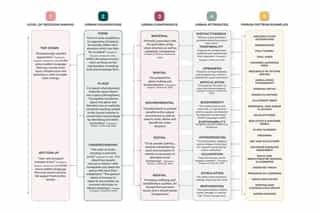
Kaplan (1995) sets out the main components that add to the level of restorative qualities an environment possesses: Fascination, Being away and Extent. Fascination is about mystery and intrigue whereas being away is about freeing the mind from the everyday. Although a different environment can be helpful in acquiring this aspect of restoration it isn't essential and instead "a change in the direction of one’s gaze, or even an old environment viewed in a new way can provide the necessary conceptual shift". Extent is more about how the place is viewed as a whole. It must be rich and coherent to keep the user interested. Again, not needing to be a large new area but instead even small areas can "provide a sense of extent." "Paths can be designed so that small areas seem much larger" and an example of this are the Japanese gardens. They provide a "sense of scope as well as connectedness".
Loose Space: Possibility and Diversity in Urban Life
Franck and Stevens (2006) then add to this by suggesting space should be loose in order for people to relax and observe "the enjoyment of diversity and the discovery of the unexpected"
Prisons are not typically considered as loose spaces due to the enforcement of rules and harsh boundaries that control behaviour. However, loose space can be "physical elements that occupants can appropriate”. If this ideology was integrated into prison environments it might give the inmates a sense of escape and ownership. As outlined in the text, being "free from judgement is one of the main pleasures of being out in public". This looseness can also be gained through the senses. "Touch, sound and smell of a place also shape people’s perceptions of it.”
There are three types of security outlined in the technical guidance for prison planning. The first being static security which is the hard infrastructure put in place to safeguard the environment. Including locks, gates, walls and fences. The next is procedural security which help staff to fulfil their jobs and the final is dynamic security ‘based on the active role of prison staff within the prison environment. How the prison is designed can alter which of these security methods take over and can "help facilitate effective interactions between prisoners and staff." Effective security can allow inmates to have more freedoms within their Greenspace. However, excessive security can be detrimental to inmates wellbeing and the rehabilitative qualities of the environment.
- Tree heights: Inmates may attempt to climb trees. Therefore dwarf species and tree locations need to be considered
- Topography: Blind spots created by topography can limit surveillance. Staff should have clear lines of site to observe on raised platforms.
- Non harmful/poisonous planting: Plants could be used to poison themselves or others. All planting should be non toxic
- Lighting: All areas should be well lit to maximise surveillance but not so severe that wildlife is disturbed.
- Materials: Anything loose, sharp or flamable might be used for violent acts. Elements should be fixed where needed, smooth and robust.
- Water depth: Water features should be below a certain depth or in areas that can be viewed for stimulation but not accessed
- Wildlife: The location of wildlife and animals should be considered to ensure no harm comes to them.
- Use of Tools: These could be used as weapons or to self harm. They would need to be kept in a secure tool shed operated by officers or run a shadow board tally system
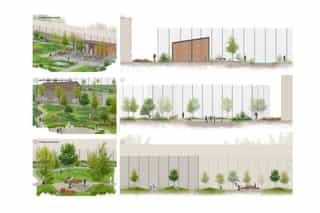
Establishing the Framework
This planning/design tool aims to develop a list of patterns suitable for the urban microcosm of a prison environment that can be implemented across the UK in a variety of ways and scales to suit individual sites. It hopes to re-establish how planning is done. Instead of a typical top-down approach, starting at the very generic large-scale policies and plans, it first requires a focus on the zoomed in human level scale to gain an understanding of what the requirements are for the unique space and diverse users. Once the requirements and understanding has been developed then the planning level decisions can be made. There is an attempt to blend together top-down and bottom-up decision-making agencies (prisoners/ prison authorities to external experts) and this reconceptualisation will change the experience of the prison environment for all involved. Focusing more heavily on rehabilitation and an understanding of the integration and balance of form, place and understanding.
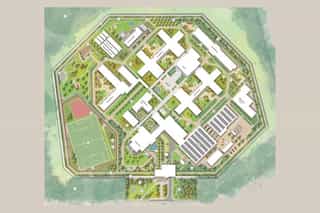
The framework is intended to be a design tool and starting point to create a unique pattern language for your project. It will provide example patterns however, these patterns are not exhaustive and should be developed, adapted and/or added to. Alongside the patterns a scoring system highlights the strongest urban component that the pattern fulfils.
Step 1: Indicating key character areas within the site.
Many are suggested within the framework (see section 4). It might be that one area needs more improvement than another and it is also useful to define the spaces that have different atmospheres. This will narrow down the patterns that will be relevant in each space and also make step 2 a lot easier.
Step 2: An assessment of the existing prison landscape.
Each character area is scored against the five urban components, broken down into the 10 urban attributes, on a scale of 1-5 (1 Being Weak- 5 Being strongest Rating) This will provide evidence of which areas of the prison environment are weaker or lacking and in which urban component area. This will influence which patterns are chosen or developed.
Step 3: Choosing and/or developing new patterns
The most successful projects must have patterns from all 5 of the component areas as “urban social sustainability requires balance of form, place and understanding.” with additional environmental and mental indicators added to the mix.
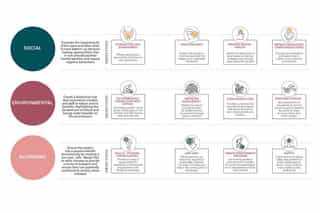
Moorland Prison, Doncaster
Clarissa chose to focus her project on Moorland Prison in Doncaster due to her personal inside connections. Moorland Prison is “committed to providing a safe and education environment where men can learn new skills to help them on release” and each person will meet professionals during their induction who will help them with health and wellbeing, substance misuse issues and personal development during and after release. Moorland already has a baseline educational program and some greenspaces that focus on rehabilitation; however, this could benefit from an enhanced prison landscape that all involved benefit from. Where inmates can explore skills, reflect on their lives and receive restorative benefits of nature, and where staff have areas dedicated to stress relief and escape.
Clarissa then assessed the current site conditions, interviewed retired staff members and created character profile interviews before gathering precedent studies. This allowed her to gain more participatory design rational and add to the human dimension of the design. The series of informed fictional characters formed as a result of the site constraints, reflecting a diverse range of participants in age, ethnicity, religion and opinions.
Next steps were to define nine-character areas which included the prison entrance, visits area, sports ground, outdoor learning environment, farms and gardens area, the yards, the streets walkways and connections, healing gardens and workshop grounds. Each area was assessed against the framework using the urban component indicator themes, giving it a potential score out of 50.
Prison Entrance
This character area is the main access point into the prison for staff, visitors and delivery/service vehicles. The current area consists of mostly mown grass with a few small shrubs. The path network is very formal, and the area has very little purpose.
Acting as the first point of contact that most external people have with the prison, this becomes a very important character area. Entering such a unique environment may be difficult for some and a big contrast from the general population environments.
Therefore, there should be lots of seating areas for respite and reflection before and after visits or work. This allows restorative decompression space where people can reflect on their experiences within the prison environment. Creating a level of familiarity is also crucial to ground people within the landscape. With this in mind a park type quality of space can be useful to create this effect.
Visits Area
The visits area is a unique space within the prison landscape because there is an intersection between the general population and inmates. However, this space currently offers no transitionality between outside the prison wall and inside. There is little access to the existing greenspace and no distinct atmosphere.
In order to establish a sense of continuity from the prison entrance, a similar character should be implemented within this space. This provides the visitors with a continued sense of comfort in what could otherwise be a challenging experience. It also allows the inmates to interact with visitors in a more 'normal' way, but to a degree that still provides the level of safety and security required.
There also needs to be a focus on providing a playful learning space for visiting children. This will allow inmates to continue and develop connections that could reduce potential family cycles of incarceration or damaging negative emotions around separation. Helping to create a character area that is socially restorative for both inmates and visiting members of the public.
Sports Ground
The sports ground is a useful area for inmates to socialise and express themselves in a group setting. The existing space is large with a multiuse sports pitch and other sport markings. However, it lacks other interesting elements that would contribute to the overall experience.
To improve this character area there should be a focus on what activities could prove mentally and socially restorative to a wide demographic. This could include more individualised sports such as running, small group activities such as ping pong, to large group activities such as football. Having this range of active use makes the area more accessible to the majority that may not enjoy certain types of sport, without excluding them from this large greenspace entirely.
To develop the restorative qualities of this space further planting should be used in a way that stimulates and creates interest in the surrounding spaces.
Learning Environment
This space has been identified as an area that has the potential to be developed into a restorative learning hub. Contact with nature was highlighted as a major factor in rehabilitation and restoration. Therefore bringing inmates outside for seemingly everyday education classes allows them to spend a greater amount of time outdoors. The act of 'learning' in this space is not only considered in the conventional sense. It could also provide room for counselling and mental health workshops. Where inmates learn about their emotions and how to deal with them. Providing calming outdoor space to work on their inner environment, whilst understanding the benefits of their external one.
Farms and Gardens Area
The existing farms and gardens area has the built infrastructure to facilitate basic allotments and polytunnels for indoor growing. However this space is not utilised to its highest potential.
In order to improve this character area there needs to be an expansion of activities towards more sustainable and forward thinking approaches. This could include hydroponics or vertical urban farming. To beehives and bug hotels.
These are transferable skills that provide inmates with a sense of hope and valuable information for when they get released. Not only this but Stuart-Smith states that "Tilling the earth works on the inner landscape as well as the outer, quintessentially, it is a transformative action". Greenspace, especially when used in a productive sense, such as Gardening takes our emotions and instead channels them into the service of growth. It becomes an in-between place where it is difficult "to neatly categorise what is ‘me’ and what is ‘not-me’ Somewhere "to coexist free from the pressures of everyday life"
The Yards
The yards are one of the most important character areas within the prison environment because it is where the majority of inmates spend most of their time. Currently, the yards are basic concrete spaces with no character and nothing of interest to stimulate or benefit the inmates.
This space should be a direct connection to nature where inmates can take time out to reflect or socialise daily. They should have things to occupy their time and spaces to sit so that this becomes a social dwell space. There should also be more permeability and transitionality between the inside and outside to make the time they are inside more enjoyable. Being able to see green spaces, especially trees and planting, is hugely beneficial to their mental health and allows them to focus on the changes day to day. A visual queue that life is dynamic.
Extra attention should be paid within this character area to ensure maximum safety and security guidelines are met. With a large density of inmates in one place accidents and/or outbursts need to be avoided.
The Streets, walkways and connections
The current walkways lack purpose and instead are simply used as places to walk through quickly without paying much attention. To improve the quality of these spaces the areas should be seen as key break out areas for staff to take time away from the stress of the job as well as inmates to have visual stimulation from inside their houseblocks and moving around the prison.
This character area covers a large amount of the site and therefore can provide a sense of journey as one moves through the space. Implementing a range of planting will help to create fascination and mystery whilst also providing a biodiverse environment that has the potential to attract more wildlife.
In areas where inmates have visual accessibility but not physical accessibility, patterns such as water features and other sensory aspects should be considered. Sound for example can have a huge impact peoples wellbeing and this is a safe way to include this within the prison environment.
Healing Gardens
This section of the prison is already used partly as a healing garden for staff and inmates. On one side is the staff gardens, currently underused and without a unique character compared to the rest of the prison landscape. On the other side a space for inmates with sensitive larger scale mental health issues to use as a restorative greenspace. However, neither space is effectively creating a healing environment. The mown lawn, shrubs and odd raised planter isn't enough to provide a sufficient restorative experience.
This character area should be used by staff as a break away area to re-centre during the day when work may become overwhelming. For inmates, it should be a highly reflective area that evokes a sense of calm. To create this type of atmosphere there should be seating opportunities, sensory planting and water features to promote reflection. The planting moving in the breeze, or the ripples on the water are all imagery that help to create a healing atmosphere.
Workshop Grounds
The workshop space is used for storing tools with little greenspace or atmosphere and is currently under-utalised. This area should be seen as a development space to retrain the inmates, giving them a sense of hope and a forward thinking mindset. As well as this, it also actively stimulates them whilst they are in prison and allows them to put their energy into something productive.
To improve the quality of the space there should be more transitional zones including covered outdoor working areas and spaces that can be opened up or closed off when required.
Integration of greenspace can also be useful here to soften the hard practical space needed to facilitate the workshops. This planting could however be in containers that can be moved if necessary.
Consultation Event: interactive Model Workshop
Providing opportunities for bottom-up decision making discussions is vital for creating the most successful and sustainable prison landscapes. It facilitates pattern selection whilst giving a voice to the people that will be impacted the most. If inmates and staff feel as though they are being heard and their needs met they are more likely to care for and appreciate the implementation of schemes in the future.
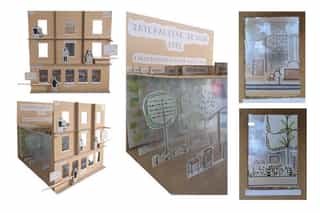
The idea of having a set base template is to show that no matter what the existing built form, it is the implementation of patterns that can bring a space to life. Taking the focus away from the storage of people and turning it towards rehabilitation through restorative environments.
This workshop was an opportunity for inmates and staff to see for themselves what impact different patterns can have from their main viewpoint. Patterns could be added, removed or rearranged. Providing useful information that would determine what features they consistently want within their landscapes and in what proximity to their viewpoint they prefer.
“Looking back at the project now and talking about it with people inside and outside the industry, it is clear to me that the prison service needs to work towards reform and rehabilitation. The hope through doing this is to reduce reoffending rates and improve the mental health crisis going on at the moment. I think the best and keyway to do this will be through the landscape. Reimagining what this space can provide for the people within the prison boundary. Instead of it being a wasted space, lacking in purpose and use… It could instead become a productive environment in many ways. Developing skills, improving health and having a positive impact on the people, economy and climate.”
Related Thoughts
Regenerative Urbanism - Principle 1: Designing for co-evolution
Regenerative Urbanism - Principle 1: Designing for co-evolution
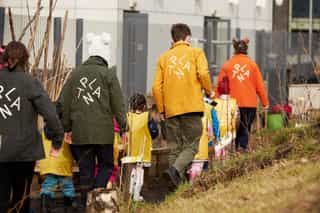
Power of Networks

Power of Networks
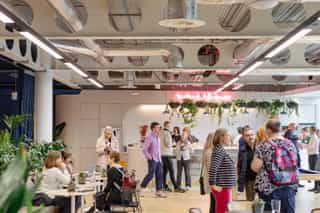
B Local, Be Helpful!



